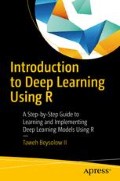Abstract
This model’s development can be traced back to the 1950s, where researchers Hubel and Wiesel modeled the animal visual cortex. At length in a 1968 paper, they discussed their findings, which identified both simple cells and complex cells within the brains of the monkeys and cats they studied. The simple cells, they observed, had a maximized output with regard to straight edges that were observed. In contrast, the receptive field in complex cells was observed to be considerably larger, and their outputs were relatively unaffected by the positions of edges within the aforementioned receptive field. Beyond image recognition, for which CNNs originally gained and still retain their notoriety, CNNs have considerable other applications, such as within the fields of natural language processing and reinforcement learning.
Access this chapter
Tax calculation will be finalised at checkout
Purchases are for personal use only
Author information
Authors and Affiliations
Rights and permissions
Copyright information
© 2017 Taweh Beysolow II
About this chapter
Cite this chapter
Beysolow II, T. (2017). Convolutional Neural Networks (CNNs). In: Introduction to Deep Learning Using R. Apress, Berkeley, CA. https://doi.org/10.1007/978-1-4842-2734-3_5
Download citation
DOI: https://doi.org/10.1007/978-1-4842-2734-3_5
Published:
Publisher Name: Apress, Berkeley, CA
Print ISBN: 978-1-4842-2733-6
Online ISBN: 978-1-4842-2734-3
eBook Packages: Business and ManagementApress Access BooksBusiness and Management (R0)

